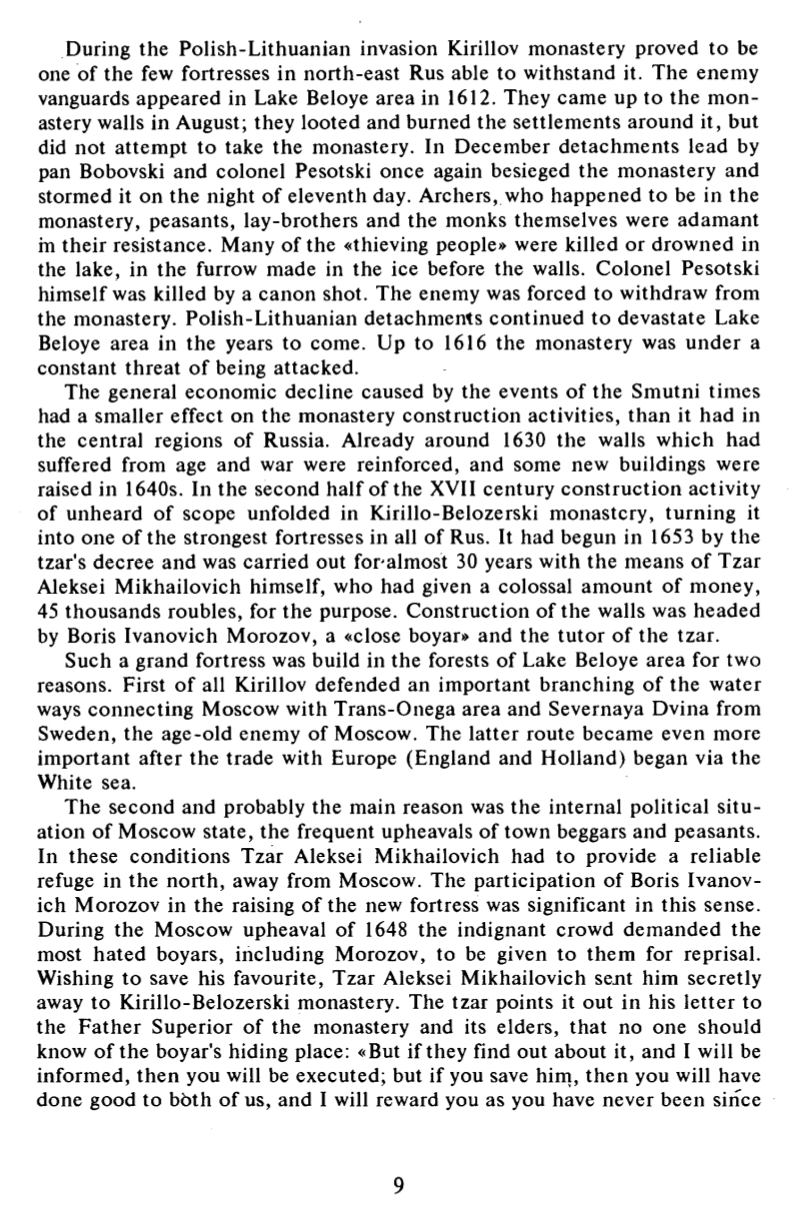

During the Po lish -L ithuan ian invasion Kirillov monastery proved to be
one o f the few fortresses in no rth -east Rus able to w ithstand it. The enemy
vanguards appeared in Lake Beloye area in 1612. They came up to the m on
astery walls in August; they looted and burned the settlem en ts around it, but
did no t attem p t to take the monastery. In December de tachm en ts lead by
pan Bobovski and colonel Pesotski once again besieged the monastery and
stormed it on the night of eleventh day. Archers, who happened to be in the
monastery, peasants, lay-bro thers and the monks themselves were adam an t
m their resistance. Many of the «thieving people» were killed or drowned in
the lake, in the furrow made in the ice before the walls. Colonel Pesotski
himself was killed by a canon shot. The enemy was forced to w ithdraw from
the monastery. Po lish -L ithuan ian detachmen ts con tinued to devastate Lake
Beloye area in the years to come. Up to 1616 the monastery was unde r a
constan t th rea t o f being attacked.
The general econom ic decline caused by the events o f the Smutni times
had a smaller effect on the monastery construction activ ities, th an it had in
the cen tral regions of Russia. Already around 1630 the walls wh ich had
suffered from age and war were reinforced, and some new buildings were
raised in 1640s. In the second ha lf of the XVII cen tury con stru c tion activ ity
o f unheard o f scope unfolded in Kirillo-Belozerski monastery , tu rn ing it
into one o f the strongest fortresses in all o f Rus. It had begun in 1653 by the
tzar's decree and was carried out for-almost 30 years w ith the means o f Tzar
Aleksei M ikhailovich himself, who had given a colossal amoun t o f money,
45 thousands roubles, for the purpose. Construction of the walls was headed
by Boris Ivanovich Morozov, a «close boyar» and the tu to r o f the tzar.
Such a grand fortress was build in the forests o f Lake Beloye area for two
reasons. First o f all Kirillov defended an importan t branch ing o f the water
ways connecting Moscow with Trans-Onega area and Severnaya Dvina from
Sweden, the age-old enemy o f Moscow. The la tte r route became even more
im po rtan t after the trade with Europe (England and Ho lland) began via the
White sea.
The second and probably the main reason was the in ternal po litical s itu
a tion o f Moscow state, the frequent upheavals of town beggars and peasants.
In these cond itions Tzar Aleksei M ikhailovich had to provide a reliable
refuge in the no rth , away from Moscow. The pa rticipa tion o f Boris Ivanov
ich Morozov in the raising o f the new fortress was significant in th is sense.
During the Moscow upheaval of 1648 the indignant crowd demanded the
most ha ted boyars, including Morozov, to be given to them for reprisal.
Wishing to save his favourite, Tzar Aleksei M ikhailovich sent him secretly
away to K irillo-Belozerski monastery. The tzar points it out in his le tte r to
the F a th e r Superior o f the monastery and its elders, th a t no one should
know o f the boyar's hiding place: «But if they find out about it, and I will be
informed , th en you will be executed; but if you save him , th en you will have
done good to bb th o f us, and I will reward you as you have never been since
9















